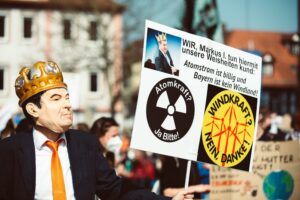/* Add some basic styling */
body {
font-family: Arial, sans-serif;
margin: 20px;
}
h1 {
font-size: 24px;
font-weight: bold;
}
section {
margin-bottom: 20px;
}
S. RES. 323 – Urging the United States to lead a global effort to halt and reverse the nuclear arms race
Introduced in the 119th Congress
July 16, 2025
Mr. M. ARKEY (for himself, Mr. M ERKLEY , Mr. W ELCH , Mr. S ANDERS , and Mr. V AN H OLLEN ) submitted the following resolution; which was referred to the Committee on Foreign Relations
RESOLUTION
Urging the United States to lead a global effort to halt and reverse the nuclear arms race.
- Whereas, since the height of the Cold War, the United States and the Russian Federation have dismantled more than 50,000 nuclear warheads, but approximately 12,000 nuclear weapons still exist and pose an intolerable risk to human survival;
- Whereas the United States and the Russian Federation, which possess an estimated 95 percent of nuclear weapons, have a special responsibility to meet their obligations under Article VI of the Treaty on the Non-Proliferation of Nuclear Weapons, done at Washington, London, and Moscow July 1, 1968 (21 UST 483) to “pursue negotiations in good faith on effective measures relating to cessation of the nuclear arms race at an early date and to nuclear disarmament, and on a treaty on general and complete disarmament under strict and effective international control”;
- Whereas President Ronald Reagan said, in his January 1984 State of the Union Address, “A nuclear war cannot be won and must never be fought. The only value in our two nations possessing nuclear weapons is to make sure they will never be used. But then would it not be better to do away with them entirely?”;
- Whereas, according to scientific studies and models, the use of even a tiny fraction of nuclear weapons could cause worldwide climate disruption and global famine by lofting millions of tons of soot into the upper atmosphere, which would cause climate disruption across the planet, cutting food production and putting hundreds of millions of people worldwide at risk of death due to famine;
- Whereas, according to numerous scientific studies and models, a large-scale nuclear war would kill hundreds of millions of people directly and cause unimaginable physical destruction and environmental damage, including even more severe catastrophic climate disruption due to lower temperatures across the planet not seen since the last ice age;
- Whereas, during the course of the nuclear age, there have been technical miscalculations, misinterpretations of adversary behavior, and crises that have caused numerous nuclear near-misses that could have led to nuclear war;
- Whereas the February 2022 invasion of Ukraine by the Russian Federation and the repeated explicit threats of the Kremlin to use nuclear weapons have significantly increased the risk of nuclear weapons use;
- Whereas tensions elsewhere in the world, including between the United States and the People’s Republic of China over Taiwan and the South China Sea, ongoing tensions between India and Pakistan, and the chronic security crisis on the Korean Peninsula, constitute other possible flashpoints for nuclear war;
- Whereas President Biden said, “I don’t think there’s any such thing as an ability to easily [use] a tactical nuclear weapon and not end up with Armageddon.”;
- Whereas the United States retains a Cold War-era nuclear declaratory policy that allows for the first use of nuclear weapons against non-nuclear threats under “extreme” circumstances and retains a launch-under-attack posture that unnecessarily compresses Presidential decision time to launch nuclear weapons within minutes, thereby creating conditions that increase the risk of unintentional or accidental nuclear war;
- Whereas, in 2023, the Congressional Budget Office (referred to in this preamble as the “CBO”) estimated that current plans to modernize, upgrade, and maintain the nuclear forces of the United States, as described in the fiscal year 2023 budget and supporting documents, would cost $756,000,000,000 over the 2023–2032 period, which was $122,000,000,000 more than the 2021 CBO estimate for the 2021–2030 period;
- Whereas, in October 2017, CBO estimated that implementing the Nuclear Modernization Plan, which intends to upgrade and enhance nearly every element of the nuclear forces of the United States, would cost $500 billion over the next several decades.
A Call for Action
The resolution calls for a global effort to halt and reverse the nuclear arms race. It outlines a series of steps that must be taken, including:
- Leading the effort to have all nuclear-armed countries renounce the option of using nuclear weapons first;
- Implementing effective checks and balances on the sole authority of the President, as Commander-in-Chief, to order the use of United States nuclear weapons;
- Ending the Cold War-era “hair-trigger alert” posture, which increases the risk of catastrophic miscalculation in a crisis;
- Ending plans to produce and deploy new nuclear warheads and delivery systems;
- Maintaining the de facto global moratorium on nuclear explosive testing;
- Protecting communities and workers affected by nuclear weapons by fully remediating the deadly legacy of environmental contamination from past and current nuclear weapons testing, development, production, storage, and maintenance activities;
- Providing health monitoring, compensation, and medical care to those who have and will be harmed by nuclear weapons research, testing, and production, including through an expanded program under the Radiation Exposure Compensation Act (Public Law 101–426; 42 U.S.C. 2210 note).
- Aktively planning a just economic transition for the civilian and military workforce involved in the development, testing, production, management, and dismantlement of nuclear weapons and for the communities that are economically dependent on nuclear weapons laboratories, production facilities, and military bases.




